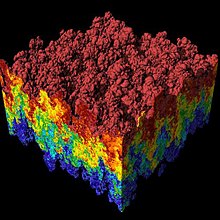
Back احتمالات مورس Arabic Morseho potenciál Czech Morse-Potential German Potencial de Morse Spanish پتانسیل مورس Persian Morse-potentiaali Finnish Potentiel de Morse French Potenziale di Morse Italian モースポテンシャル Japanese Morse-potentiaal Dutch
| Computational physics |
|---|
 |
The Morse potential, named after physicist Philip M. Morse, is a convenient interatomic interaction model for the potential energy of a diatomic molecule. It is a better approximation for the vibrational structure of the molecule than the quantum harmonic oscillator because it explicitly includes the effects of bond breaking, such as the existence of unbound states. It also accounts for the anharmonicity of real bonds and the non-zero transition probability for overtone and combination bands. The Morse potential can also be used to model other interactions such as the interaction between an atom and a surface. Due to its simplicity (only three fitting parameters), it is not used in modern spectroscopy. However, its mathematical form inspired the MLR (Morse/Long-range) potential, which is the most popular potential energy function used for fitting spectroscopic data.